Gutiérrez, C. M.; López-Corredoira, M.
Referencia bibliográfica
The Astrophysical Journal, Volume 713, Issue 1, pp. 46-51 (2010).
Fecha de publicación:
4
2010
Revista
Número de citas
10
Número de citas referidas
10
Descripción
The optical spectra of objects classified as QSOs in the Sloan Digital
Sky Survey Data Release 6 are analyzed with the aim of determining the
value of the fine structure constant in the past and then checked for
possible changes in the constant over cosmological timescales. The
analysis is done by measuring the position of the fine structure lines
of the [O III] doublet (λλ4959 and λλ5008)
in QSO nebular emission. From the sample of QSOs at redshifts z <
0.8, a sub sample was selected on the basis of the amplitude and width
of the [O III] lines. Two different methods were used to determine the
position of the lines of the [O III] doublet, both giving similar
results. Using a clean sample containing 1568 of such spectra, a value
of Δα/α = (+2.4 ± 2.5) × 10-5
(in the range of redshifts z ~ 0-0.8) was determined. The use of a
larger number of spectra allows a factor ~5 improvement on previous
constraints based on the same method. On the whole, we find no evidence
of changes in α on such cosmological timescales. The mean
variation compatible with our results is
1/langtrangΔα/α = (+0.7 ± 0.7) ×
10-14 yr-1. The analysis was extended to the [Ne
III] and [S II] doublets, although their usefulness is limited due to
the fact that all these doublets in QSOs tend to be fainter than [O
III], and that some of them are affected by systematics.
Proyectos relacionados

Morfología y dinámica de la Vía Láctea
El Proyecto se estructura en dos partes, diferenciadas pero complementarias: morfología y dinámica. El estudio detallado de la morfología de la Vía Láctea pretende proveer una base de datos de distribución estelar en las regiones más alejadas y extintas de nuestra Galaxia, mediante el desarrollo de modelos semiempíricos a partir de la información
Martín
López Corredoira